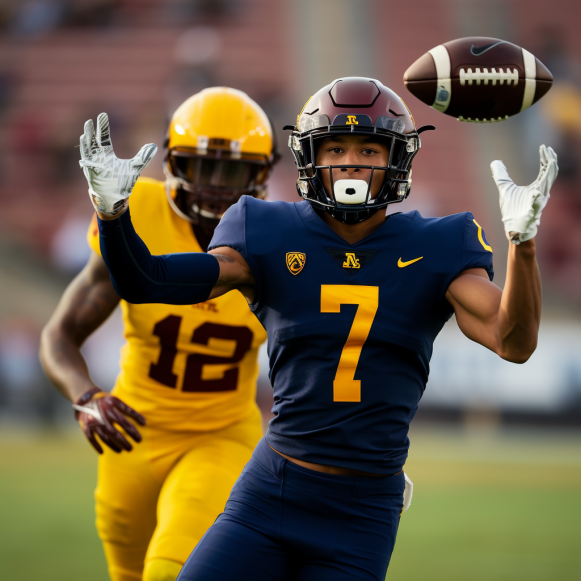Pac-12 collapse: Winners and losers from the 2023 realignment cycle
At the Pac-12’s preseason media event in Las Vegas two weeks ago, commissioner George Kliavkoff provided a succinct, confident assessment of the college sports landscape. “We’ll get our media rights deal done, and then we’ll announce the deal,” he promised. “I believe the realignment in college athletics is coming to an end for this cycle.”
He was only six schools off.
The 2023 cycle of realignment appears to be over, following a mass exodus that decimated the 108-year-old conference. (Caution: See the ACC section below.)
Our analysis of the winners and losers…
Loser: West Coast college sports. Eight athletic departments have a secure future: Washington, Oregon, USC, and UCLA will join the Big Ten next summer, while Arizona, ASU, Colorado, and Utah will join the Big 12. The future of Washington State, Oregon State, Stanford, and California is uncertain. But the sporting scene will never be the same for everyone involved — players and coaches, fans and alumni. At its core, and at its best, college football is a regional sport built on traditions and rivalries. That’s gone, possibly for good, as schools compete for media dollars and the sport quickly devolves into a mini-NFL.
Winner: Fox. The Big Ten’s media rights owner orchestrated the 2022 raid that took USC and UCLA and pushed the Pac-12 into crisis mode. Fox returned for the kill shot this week, putting money behind the offers to Oregon and Washington that ultimately doomed the conference. As a result, the network will control the media rights to the top Pacific Time Zone brands (USC, UCLA, Oregon, and UW), leaving ESPN without premium West Coast inventory. The conferences and schools, as we have written numerous times over the years, are pawns in the chess game that the two networks are playing. Outside of the Pac-12 presidents’ multi-year collective, no single entity is more responsible for the Pac-12’s demise than Fox.
Losers: Washington State and Oregon State. Pacific Northwest ‘State’ schools in perilous financial situations face uncertain futures in a dying league, victims of geography and resources rather than competitive performance. There are few relocation options; there are no good relocation options. The Cougars and Beavers are the unlucky poster schools for realignment at its harshest.
Winner: Arizona fans. Except for Colorado, none of the long-standing Pac-12 universities fit better in the Big 12 than Arizona, a basketball school that will join a basketball league. (Its location also allows for easy travel throughout the Southern Plains.) However, be careful what you wish for. Is playing two games against Kansas worth the cost of conference losses, lower seeds, and tougher paths in the NCAA Tournament? The trajectory of Arizona’s program over the next decade will be fascinating to watch.
Losers: Stanford and Cal. As difficult as it may be to believe, two schools with hundreds of NCAA championships and Nobel Prizes, as well as access to the Bay Area tech scene, are on the verge of losing their Power Five status. Sure, they’ve struggled on the field, but the major conferences are littered with second-tier football programs. Stanford can afford to keep a demotion; Cal cannot. Both schools are undoubtedly pursuing Big Ten membership at steep discounts… and with dim hopes.
Winner: Mountain West. The conference anticipated losing San Diego State to the Pac-12. Instead, it retained the Aztecs and could very well add the Pac-12’s final four teams. If Stanford rises under new coach Troy Taylor and joins quality programs such as Boise State, Fresno State, and San Diego State, the resulting 16-team MW will produce a highly competitive football product. (For years, the gap between the Pac-12’s bottom two-thirds and the MW’s top third has been negligible.) Having said that, we should consider the possibility of the Pac-4 banding together and conducting a raid on the top programs in the MW.
Loser: Second-tier schools in the Big Ten. On-field success was already a challenge for Minnesota, Purdue, Illinois, and others. They must now contend with the Huskies and Ducks.
Winners: Washington and Oregon. We don’t see the Northwest powers as clear-cut winners in the short term; they would have been better off in a reasonably stable and prosperous Pac-12 in many ways. (Neither school believed that option existed based on their actions.) The Huskies and Ducks, on the other hand, are poised for victory — and full shares of the Big Ten’s massive revenue — when the conference signs its next media deal at the end of the decade. Fans and athletes will benefit from less travel and more rivalries if the Big Ten eventually adds Stanford and Cal to form a significant West Coast division.
Losers: USC and UCLA football. The programs hoped that joining the Big Ten last summer would give them a competitive advantage over Oregon and Washington, who were left behind in a depleted Pac-12. Instead, the Ducks and Huskies will share the same platform and, eventually, the same cash as their L.A. rivals.
Winners: USC and UCLA athletes. The additions of Oregon and Washington will help to alleviate the enormous travel demands that come with being a member of the Big Ten, particularly for Olympic sports.
Loser: ACC stability. Florida State hasn’t been shy about expressing its desire to leave; Clemson, North Carolina, and Miami are also dissatisfied with the ACC’s revenue structure (though haven’t been as vocal about it). The future of the conference — and this round of realignment — appears to be on a knife’s edge. And now we have a precedent. Will FSU and others take advantage of that cover to detonate the ACC?
Winner: The SEC. The elimination of a Power Five conference will result in changes to the College Football Playoff selection process, with one of the six automatic berths being eliminated and a seventh at-large slot being added. The end result? More offers for the SEC to consider. (The Big Ten will be pleased as well.)
Loser: Pac-12 commissioner George Kliavkoff. Yes, he inherited a difficult situation from his predecessor, Larry Scott, and he had little bargaining power due to Fox’s chess moves in 2022. However, this is also true: Kliavkoff badly misplayed his hand, particularly with regard to the media rights process. Kliavkoff, an accomplished sports executive hired two years ago for his visionary approach, now has a resume that includes the demise of a Power Five conference and a significant role in the demise of college sports tradition on the West Coast. How long can he keep leading the Pac-12? Does he have any credibility with the remaining colleges? This should become clear over the next few weeks.
Winner: Big 12 commissioner Brett Yormark. He entered the fray with advantages Kliavkoff lacked, most notably the prioritization (by his presidents) of stability over revenue and Fox’s strategic imperative to maintain its relationship with the Big 12 (for access to Texas), whereas the Pac-12 was no longer required (access to the L.A. market came with USC and UCLA in the Big Ten). However, Yormark’s aggressive approach is ideal for realignment, particularly with conferences other than the Big Ten and SEC. His strategy was brilliant, and his league is much stronger as a result.
Loser: West Coast Olympic sports. When the increased travel for athletes at schools joining the Big Ten is combined with the uncertainty that awaits those at the four schools left behind, the future does not look promising. If there was any doubt that every available dollar should be poured into football, the last 72 hours have dispelled it. Stanford has 134 NCAA championships and a hazy history to show for it.
Winner: Coincidence. The Pac-12’s spectacular collapse comes ahead of what could be the best football season in years, with a slew of top-25 teams and Heisman Trophy contenders. To what extent will the threat of extinction loom over the stadiums over the course of 13 Saturdays? The Apple Cup and the Oregon-Oregon State game will be spectacular.
Losers: Pac-12 presidents. This is a complicated topic because several current presidents are clear winners based on the landing spots for their schools. However, as the conference’s collective stewards over the last 12-15 years, they have failed miserably, completely and completely — from academic arrogance to a lack of vision to a lack of interest in college football. Unfortunately, the disastrous leadership will affect thousands of athletes and hundreds of employees at the four remaining schools, as well as all fans and alumni.




